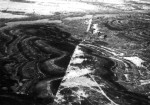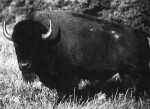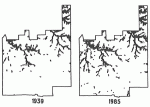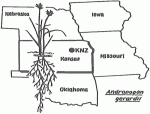The tallgrass prairie was once the second largest biome in the contiguous United States. Today there are only small remnants. The Konza Prairie Research Natural Area, a 3,400-ha tract of native tallgrass prairie 10 km south of Manhattan, Kansas was purchased in 1971 by The Nature Conservancy and is managed by the Division of Biology, Kansas State University, for the purpose of long-term ecological research. Konza Prairie is representative of the Flint Hills in eastern Kansas, with relatively steep slopes and distinctive limestone benches. Soils on hillsides and uplands are typically shallow and rocky while lowlands usually have deeper, more permeable soils. The Konza Prairie was part of the first cohort of LTER sites selected in 1981, and is now in its 11th year of funding.
Development of the LTER Program
During the initial LTER funding cycle (LTER I), Konza Prairie scientists developed a research protocol emphasizing comparative studies on the effects of annual spring fire in tallgrass prairie watersheds. Comparisons were made primarily with unburned watersheds. In LTER II, we expanded these research efforts to include various fire frequencies (i.e., annual, two-year, four-year and unburned watersheds). Furthermore, we increased our sampling efforts and implemented additional experiments to examine belowground net primary production and the interactions of soil biota with root dynamics. Throughout these two funding cycles, data collected was usually limited to upland (shallow soils) and lowland (deeper soils) sites. During LTER II, our research program was significantly enhanced by collaborative research with the NASA-FIFE program (FIFE=First ISLSCP Field Experiment; ISLSCP=International Satellite Land Surface Climatology Project). Techniques relevant to scaling ecological phenomena and remotely-sensed data to levels compatible with climate models continue to be developed as a result of this collaboration.
Present LTER Research
Ongoing LTER research on Konza Prairie represents the most significant expansion of our long-term ecological research effort to date. With the re- introduction of native ungulates (American Bison) to the prairie, we are examining their impacts on the tallgrass prairie ecosystem. Specifically, our objective is to understand how grazing influences biotic processes and patterns imposed by fire frequency over the landscape mosaic. To accomplish this goal, we have assembled a multidisciplinary team of over 20 scientists from Kansas State University, Ottawa University, University of Colorado, University of Oklahoma, University of Kansas, University of West Florida, Utah State University and several government agencies.
In addition to our core LTER effort, several other NSF-sponsored research projects continue to contribute to our knowledge of the tallgrass prairie ecosystem. For example, David Hartnett is examining in greater detail the effects of grazing by bison on individual plant populations and community structure. A conservation biology research project by Alan Knapp, Tim Seastedt and Clarence Turner focuses on the mechanisms of persistence of tallgrass prairie forbs within a “sea of grass,” and Charles Rice is leading a group of scientists in studying patterns of trace gas flux across the prairie landscape.
A cooperative agreement among the U.S. Geological Survey (USGS), USDA Soil Conservation Service, University of Kansas and Kansas State University has led to a study of the dynamics of groundwater-surface water interactions. To accomplish this, USGS has installed observation wells on one of our gauged watersheds that will allow us to characterize groundwater from different stratigraphic horizons by its chemical signature. These groundwater wells coupled with an extensive geomorphic analysis of the watershed will improve our understanding of chemical and biological processes operating at Konza Prairie.
Use of Recent Technologies
Using technologies that have only recently been made available to ecologists, Konza LTER researchers have completed a geographic information systems (GIS) analysis of the expansion of woody vegetation on Konza Prairie. Historical aerial photos have been geometrically corrected using global positioning systems (GPS) and GIS technology. Detailed analysis of the woody vegetation on Konza Prairie indicated that this vegetation type has expanded by over 54 percent from 1939 to present. This expansion is probably related to a combination of changes in land-use pattern and a reduction in fire frequency. We are also using remote sensing technology as a tool to quantitatively estimate the heterogeneity of vegetation patterns across the tallgrass prairie landscape.
Intersite Research Efforts
Konza LTER scientists have been or are currently involved with the cross-site research efforts underway within the LTER Network. Some of these projects include the intersite litter decomposition study, a comparative analysis of methane flux in small-order streams, the intersite climate database, seasonal responses of stream periphyton to nutrient enrichment, cross-biome modeling efforts, and studies of ecosystem properties across environmental gradients.
For further information: Alan K Knapp or John M Briggs, Division of Biology, Ackert Hall, Kansas State University, Manhattan, Kansas 66506-4901, 913-532- 7094 or 532-6629, aKnapp@lternet.Washington.edu or jBriggs@lternet.Washington.edu.

 Enlarge this image
Enlarge this image


